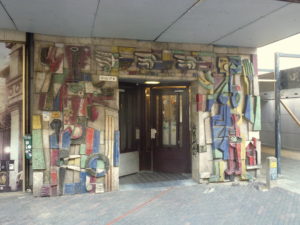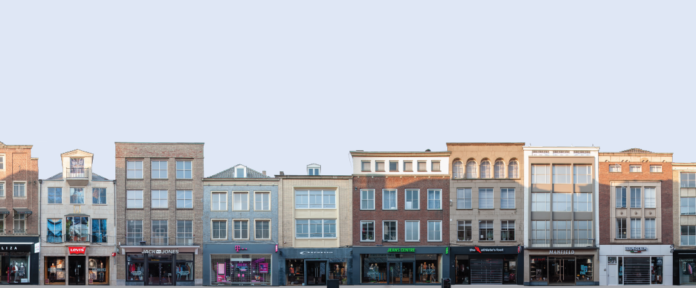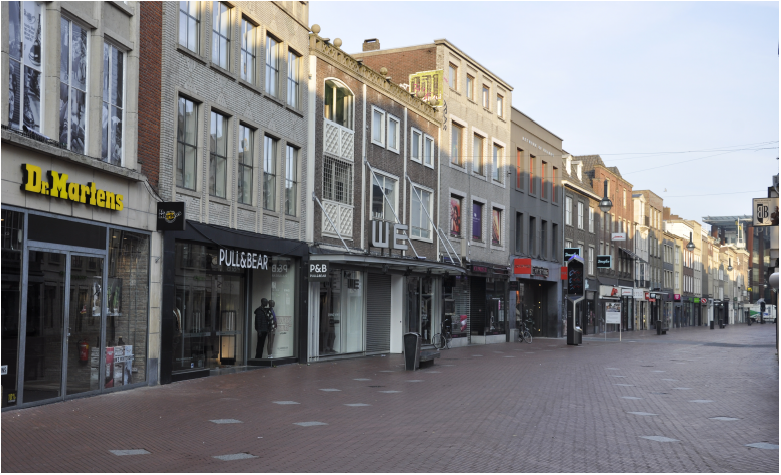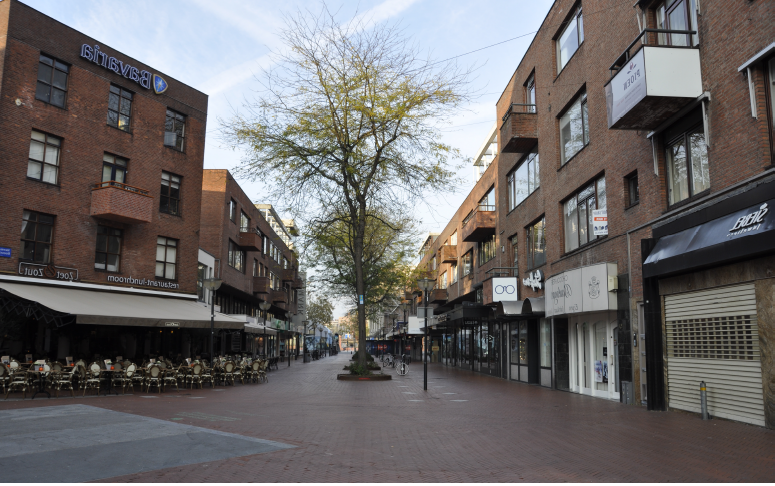If ever it makes sense to explore the city centre it is now, in our troublesome times. What usually is a hotbed of commerce, a locale for events, a destination for shopping, people watching, meeting friends over a drink or a bite, is now eerily quiet. All that normally so easily, so automatically distracts us from looking at our surroundings is on hold.
Understandably, the urge to escape the confines of our houses, the urge to compensate for all that is not possible at the moment, has noticeably increased the use of the many green spaces Eindhoven has to offer. A very positive development indeed, and one that hopefully lasts beyond the stranglehold of current restrictions on our options. And chances are good that it will because, once experienced, the joys of the green outdoors at our doorstep will keep luring us.
But apparently, given the empty city centre, way too few of us realise that our build environment also has something to give us. We should be grateful for the one redeeming feature of that emptiness. Normally, the hustle and bustle of the city sucks up our attention. The quiet streets are an opportunity to discover its interesting architecture. If ever it will be easy to notice the building facades above the distracting eye level commercial seducers, it is now. However, you may wonder, why you would want to. Spectacular sights tend to grab one’s attention, never mind the presence of distractions. If Eindhoven’s city centre hasn’t grabbed your attention yet, why even bother?
The fact that loud voices are heard whether you listen or not doesn’t mean that whispers don’t deserve to be heard. Many of the city centre buildings are whispers, easily missed, but worth listening to. In general, having an eye for one’s surroundings, be they natural or artificial, especially if they are your day to day environment and thus tend to be navigated on automatic pilot, can be a source of wonder, awe, curiosity, stress release, and much more. When in need of these goodies, as we are always, but even more so in troubled times, our biophilia makes us look for the goose that lays those golden eggs in the green outdoors. But we forget that the built environment also lays such eggs, and once it starts doing so for you, it keeps doing so. So go out and discover this urban goose!
A good tool to help with that is the Eindhoven Architecture guide that I reviewed in an earlier article in this series. The city centre of Eindhoven is very small. But it hosts a quarter of ‘the 100 best buildings’ described in the guide. You don’t really need a route. Just wandering about for an hour or two, and looking at the facades around you, book in hand, is bound to reveal most, or even all of them. Yes, I’m sure you will have seen many of them before. But I am equally sure that, unless you are an architecture fan, you have not really looked attentively and informed by a bit of background info, of the sort that the architecture guide provides. Informed looking has a weird, but wonderful effect: it cannot be undone, and thus changes you. Next time you visit the same place, good chance your attention, even if only for a moment, will be drawn to the buildings that now have become your acquaintances.
Many see the centre of Eindhoven as fragmented, messy, and lacking a Brainport worthy metropolitan dynamism and appearance. Little historical heritage, little wow, little green, dead-end and underutilised supply areas, in other words, why even bother looking around you. Big mistake! Yes, if you want to immerse yourself in a picture book ‘historic’ city centre, visit Den Bosch. Still, Eindhoven’s bewildering mixture of building styles, and unmarketed, largely unnoticed treasures make it a palimpsest that reveals a lot about the city’s long history. And even in these lockdown times, it has fascinating but often overlooked exhibitions that one can visit. As I said, no route description here, because that would spoil the fun of exploring by yourself, but just a couple of examples to stimulate your appetite. Let’s see how much more there is to discover beyond what Eindhoven’s official downtown route (nothing wrong with it! check out) suggests.
The 18 Septemberplein is a good one to start with, as you’ve undoubtedly been here many times. What secrets could it still hold? Well, you are standing where the Gender river protected the North end of the city near its confluence with the Dommel. This confluence is also the reason that Eindhoven was founded exactly here, at the crossroads of two important trading routes – from Den Bosch to Liège (Luik) and from Antwerp to Germany. As you know, the successors of these routes, the Demer-Stratumseind and the Vrijstraat-Kleine Berg still meet at the market square, and thus continue a 13th-century street pattern. I’m sure you have all used the bicycle storage, the entrance of which was once despairingly described as an ‘opengewaaide frietzak’ (blown open chips bag), and have seen the little display about the medieval city gate once located here. Did you take the time to have a good look at the remnants and read the informative background info on the wall behind them? And did you ever notice the much larger history display just around the corner? Free, and open to visitors, what more do you want in lockdown times?
By way of an aside: the 13th century sounds long ago, but in the perspective of geological time it is just a blip. And that ‘deep’ time is literally beneath your feet. The fascinating deep time story of Eindhoven’s location started at least a good 300 million years ago. The spiderweb of connections among the location of this city, the course of Dommel and Gender, the larger delta that these rivers are part of, and plate tectonic processes going back to before the age of dinosaurs, blows my mind. If you are interested in being enchanted too, have a look here.
Equally amazing is how totally different this heart of Eindhoven was before the Second World War. It used to be where the Gender was, but from the 1860s onward the 18 Septemberplein was railway tracks that separated the market centre from its much larger, much more populated Woensel neighbour. The thousands of factory labourers who had to cross these tracks every day made this the most infamous bit of railway real estate in the whole of the Netherlands. Eindhoven was heavily bombed during the war, destroying large sections of the old city centre. The post-war reconstruction efforts, inspired by visions of growth and befitting metropolitan grandeur, resulted, e.g., in an elevated railway line – approximately 80 meters North of its original trajectory – a new railway station and new station square, the 18 Septemberplein with its well known eye-catching buildings, and the rebuilding of the Hermanus Boex/Demer shopping streets. It is the latter that I want to focus on here.
The September square and these two shopping streets are a beautifully preserved example of the reconstruction architecture and urban development of the 1950s. It is the Demer and its fraternal twin that inspired this article: if ever there is good time to really discover their subtle beauties, it is now! The reconstruction of the Demer only really started during the early 1950s, when the pre-war business families, individually working with an architect and not being stingy, rebuilt their shops, with living quarters above them. The resulting variety is stunning and truly deserves heritage status. However, the modernist city authorities disliked the ‘old fashioned’ esthetics that these families went for, and their time consuming building-by-building reconstruction approach. The latter was totally understandable because they were under great public pressure to speed up the process. Thus, when the Hermanus Boex street was rebuilt in the late 1950s, they opted for a modernist esthetic. And, to speed up the reconstruction effort, rebuilding the whole street was laid out in one go, under the strict supervision of a single architectural firm. The result is that the Demer and the Hermanus Boex streets are unrecognisably different. Sure, many later changes to the buildings, and the often unimaginative (to use a euphemism) storefront designs are lamentable. But there is a dedicated effort to bring attention to this situation and lobby for improvement: the Stichting Wederopbouw Eindhoven (Reconstruction Foundation Eindhoven) published an exhaustive inventory and analysis of the state of all buildings with recommendations for their conservation. It is in Dutch only, but richly illustrated and worth leafing through (open access online) in preparation for your exploration.

Two other reconstruction era buildings that you have undoubtedly often passed but maybe not really looked at are neighbours on the Vestdijk. Hotel Cocagne (Pullman) was built in the late 1950s-early 1960s. Look at it from across the road and imagine the 1972 expansion away: you’ll see what the architect originally imagined: an impressive design, easy to like. Its neighbour which now houses the expat hub – so you might even have visited regularly – was built as a nurses’ home for the Catharine Hospital that occupied the current Heuvel Gallery site before it was relocated to Woensel. What the architecture guide calls its ‘austere’ concrete facade is a beautiful example of how the simplest of decorative touches can make all the difference. Check out the stunning ceramic reliefs at its entrances (by Hugo Brouwer, 1913-1986). In general, I am not overly impressed with Eindhoven’s artwork intended to spice up public space, but these reliefs brighten my day every time I see them.
The busier streets with interesting facades are ‘normally’, the more likely you are to have been distracted by their shopping, entertainment, and food and drink attention grabbers. Very obvious candidates fitting this profile are the Markt, the Rechtestraat , the Hooghuisstraat, Stratumseind, and the Kleine Berg. All host an eclectic mix of architectural styles, testimony to the time they were built (or redone). Once the Demer and Hermanus Boex streets have sensitised you to the esthetic of reconstruction architecture, it starts waving at you in these other inner-city shopping streets too. And much of earlier days is also remarkable.

Another building, one that you are sure to have noticed, and probably also admired the interior of, is St. Catherine’s church. It is an early neogothic masterpiece by the architect responsible for Amsterdam icons like the Rijksmuseum, and an expression of the 19th-century emancipation of Dutch Catholics. There is so much to see that this church is bound to come up with new surprises, even if you think you’ve seen them all. You will have seen the archaeological exhibition. But did you really spent time with it? May I remind you that St Catherine’s is the only ‘museum’ that currently allows you in? If the exhibit triggers your interest make sure to get your hands on a copy of the archaeological biography of little Marcus van Eindhoven, buried in the church’ predecessor around 1300! Also worthy of some real attention are its many beautiful stained glass windows. They are near all reconstruction era works (the church was damaged and lost many of its earlier windows during a WWII bombing), by noted artists like Hugo Brouwer of the former nurses’ home entrances, and Charles Eyck.

Eindhoven’s small city centre has lots more to offer and discovering that on your own, is half of the fun. So I am going to leave you to it with two last examples. The first is directly connected to the Catharina church: its graveyard, with heritage status chapels and monuments of well-known industrialist families, a green oasis often bypassed because its entrance is somewhat hidden away. Just up the road is a totally different gem, one that I would never have found without the architecture guide. Look for an urban courtyard and an eye-catching wood covered building containing two urban residences by one of Eindhoven’s prime architectural firms.
Next time you need outside air and consider your umptieth walk around the busy Genneper Parken, try the city centre as an alternative. You are going to be surprised.
For Eindhoven News: Roger Henke.
More background info, resources, and thoughts, visuals and audio about Eindhoven, The Netherlands, cities, exploring environments and assorted fancies: https://runandwalkeindhovenregio.org/
Episodes in the Exploring Eindhoven Region series:


















